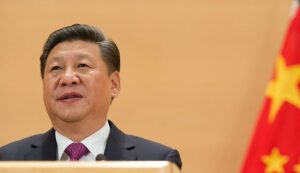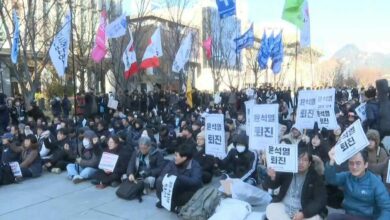Chairman Xi Jinping has shown great seriousness in advising the PLA to prepare for war
Hong Kong: When Chairman Xi Jinping warns the People’s Liberation Army (PLA) to prepare for war, he means it. The fortification of military air bases and the building of a brand-new command structure to shield people from bombing are concrete examples of such preparations.

Numerous PLA facility fortification projects are visible on satellite photography, but the most shocking of them is a brand-new command complex that is now being built around 25–30 kilometers west–southwest of Beijing’s downtown.
The Financial Times revealed the existence of this enormous structure in late January, which was most likely intended to serve as the PLA’s command and control center during times of conflict. The location is ten times bigger than the Pentagon and spans over 1,500 acres.
Deep trenches that have been dug into the earth are visible in satellite photos; they will ultimately hold reinforced bunkers that are probably robust enough to withstand nuclear assault. When finished, it will be the biggest military command center in the world. More than 100 cranes operate there every day, and some observers have already called it Beijing Military City.
The construction site is around 4 km wide. By spreading the facility out over a larger region and digging deep into the earth, it is more likely to survive an assault. It is now unable to confirm every detail of the new complex, but it seems that there are several underground nodes linked by underground passages, maybe even a metro system of its own.
However, is it possible that experts are wrong and the whole region is just a residential neighborhood? Given the lack of expansive, brand-new residential real estate building sites as China suffers from a severe economic downturn, the location is undoubtedly unique.
Interestingly, no new construction in this specific location close to Beijing is being marketed or advertised commercially. All of this is proof that a top-secret project is being developed for the military, and the Chinese internet remains mute about what is taking place at this workplace.
Despite the absence of military security, the massive construction site is off-limits to the public, and checkpoints make sure that no intruders may enter. Nearby hiking and tourism destinations are now prohibited, and drones and photos are prohibited.
To make room for this new construction, houses in the nearby Qinglonghu neighborhood were also being demolished. The expansive site’s construction started in the middle of 2024, with its estimated halfway point located at 39°49’7.65″N 116° 3’58.22″E.
Given that the Chinese Communist Party is going all out to commemorate the PLA’s 100th anniversary in 2027, such a massive endeavor should not be shocking. Xi hopes to develop the power to invade Taiwan by that time. Xi literally directed the PLA to “accelerate the integrated development of mechanization, informatization and intelligentization, while boosting the speed of modernization in military theories, organizations, personnel and weapons and equipment.”.
China’s Foreign Ministry has not commented on the new construction’s existence or function as of the time of writing. The Financial Times was informed by the Chinese Embassy in Washington that it was “not aware of the details” but emphasized that China was “committed to the path of peaceful development and a defense policy that is defensive in nature.”
The Central Military Commission (CMC), the PLA’s main guarded headquarters and the highest body under Xi, is now situated in Beijing’s Western Hills at around 40°0’39.27″N 116°14’10.70″E. This massive but dilapidated subterranean stronghold, also called the Joint Combat Command Center, was built during the Cold War decades ago.
At this point, it seems that the new complex will replace Western Hills since it will undoubtedly be more secure against American weaponry, such as nuclear weapons and so-called “bunker buster” bombs.
Modern digital and communication technologies that have been included in the building from the start will be another significant improvement at the new location. Therefore, it seems that this structure is a kind of “doomsday bunker” for China. One of the PLA’s main weaknesses has always been its lack of unity, but a command center of this kind would supervise all of the PLA’s operations, particularly the leadership of combat units during times of conflict.
The Financial Times reported Dennis Wilder, the former head of the CIA’s China analysis, as saying, “If confirmed, this new advanced underground command bunker for the military leadership, including President Xi as the Chairman of the CMC, signals Beijing’s intent to build not only a world-class conventional force but also an advanced nuclear warfighting capability.” The Financial Times exposed the new underground facility near Beijing.
Indeed, Xi is increasing PLA Rocket Force (PLARF) capabilities at a never-before-seen rate. By 2030, the PLARF is expected to have 1,000 nuclear warheads, with more to follow. Currently, China has more than 600 nuclear warheads in action. In addition, the PLA has the largest hypersonic missile arsenal in the world, with over 400 intercontinental ballistic missiles (ICBM) capable of striking the US mainland.
The “Military and Security Developments Involving the People’s Republic of China 2024” study from the Pentagon was released in December of last year. China is probably going to double the number of DF-5 liquid-propellant ICBMs to 50 silos, and it verified three additional missile silo fields deep within the country that include 320 ICBM silos. In addition to the well-known road-mobile launchers, the United States anticipates the DF-41 ICBM to be used in silos and on railroads.
Additionally, China is now maintaining a “launch on warning” posture for its early-warning counterstrike, which Washington refers to as having certain nuclear troops on high alert. China is reportedly building a huge laser-ignited fusion research facility in the Sichuan Province town of Mianyang as part of its audacious and mysterious nuclear weapons buildup.
This state-of-the-art research center will support renewable power-generating research and nuclear weapons design work. Four recently constructed peripheral arms with laser bays are seen in satellite pictures, along with a central experimental bay that most likely houses a target chamber filled with hydrogen isotopes. In such a facility, nuclear fusion is accomplished without the need for real nuclear detonations by compressing and heating fuel using powerful lasers.
The address of the facility is 31°32’41.60″N 104°44’27.48″E. It is about half as large as the National Ignition Facility in the United States. Subcritical experiments and laser-induced fusion are essential for preserving secure and dependable nuclear arsenals.
“A couple of thoughts: first, you could argue that this construction effort is good because it indicates that China is not planning on relying on future nuclear weapons tests,” said Decker Eveleth, a researcher with the U.S.-based research company CNA Corp. The Comprehensive Nuclear Test Ban Treaty is strengthened by such a facility.
However, Eveleth said, “Such a facility may enable China to engineer and deploy new and more advanced nuclear weapon designs, including more compact warheads. If they decide to take that course, it will have some effects on China’s stance going forward.
Moving on to other military installations in China, the PLA has been actively building reinforced shelters at several air bases to safeguard equipment and aircraft. The Hudson Institute released a paper last month titled “Concrete Sky: Air Base Hardening in the Western Pacific” that examined this problem.
US “airfields face a threat of severe Chinese military attack,” according to the authors, Thomas H. Shugart and Timothy A. Walton. US aircraft and their supporting equipment may be attacked at airfields across the world, including in the continental United States, by PLA strike forces using aircraft, ground-based missile launchers, surface and subsurface boats, and special forces.
They proposed that “the overwhelming majority of US aircraft losses would likely occur on the ground at airfields (and that the losses could be ruinous)” in the event of an Indo-Pacific war with China.
In addition, they complained that “the US military has devoted relatively little attention and few resources to countering these threats compared to developing modern aircraft.”. “The People’s Republic of China (PRC) has made significant investments to defend, expand, and fortify airfields because it anticipates that they will be heavily attacked in a potential conflict,” Shugart and Walton said.
China has undertaken a systematic and countrywide endeavor to increase the air bases’ resilience during the last ten years. China now possesses more than 3,000 aircraft shelters overall, excluding public and commercial airfields, thanks to the PLA’s more than twofold increase in hardened aircraft shelters (possessed) and unhardened individual aircraft shelters (IAS) at military airfields.
The PLA now has over 800 HASs, compared to around 370 in 2010. In addition, the number of non-hardened shelters has more than doubled, rising from 1,100 to over 2,300.
Bases close to China’s borders, especially those in the east, south, and west, have seen the majority of these upgrades. The great bulk of Chinese combat aircraft can be housed and hidden in this profusion of reinforced shelters. In addition, “China has also added 20 runways and more than 40 runway-length taxiways and increased its ramp area nationwide by almost 75%.” Over 650 HASs and over 2,000 non-hardened IASs are now stationed at 134 Chinese air stations that are 1,000 nm from the Taiwan Strait.
In contrast, the United States, excluding South Korean facilities, has constructed just two HASs, forty-one IASs, one runway, one taxiway, and an additional seventeen percent of ramp space within a 1,000-nm radius of Taiwan. Only a third of China’s military airfield capability is now available to the US military within 1,000 nautical miles of Taiwan.
Thus, according to the Hudson Institute analysis, “this leads to an imbalance wherein PLA troops would have to fire many fewer’shots’ to suppress or destroy US, ally, and partner airfields than the opposite.
If the US used military airfields in Japan, the Philippines, South Korea, and Taiwan, the imbalance would be about 25%; if it used just Japanese military airfields, it might be as high as 88%.
Operationally, this may make it far simpler for the PRC to maintain air operations throughout a confrontation than for the US; strategically, this destabilizing disparity might encourage the PRC to take the lead. If China perceives a chance to neutralize enemy airpower on the ramp, it may start a war.
The authors made two explicit warnings. First, it is obvious that the PRC anticipates intense attacks on its airfields in the event of a war and has invested much in their defense, expansion, and fortification. Second, the size and breadth of US investments have been far reduced, and they are not in line with the serious threat situation that US troops are confronting.
In order to cripple opponent air forces while they are still on the ground, Xi will need to pursue air superiority if he chooses to strike Taiwan. With significant investments in long-range attack aircraft, such as the H-6K, which can carry cruise missiles, and a sizable stock of ballistic missiles capable of hitting airfields in countries like Japan and the Philippines, the PLA has been gaining the capability to achieve this. Guam may be reached by the PLARF’s estimated 1,300 medium-range ballistic missiles and 500 intermediate-range missiles.
Without a doubt, China is capable of posing a severe danger of bombardment to the United States. “These activities are consistent with PLA expectations that US or other forces will attack the PRC from multiple azimuths in a conflict related to Taiwan or other scenarios,” the Hudson Institute assessment said. Therefore, China would be better able to produce aircraft to protect its airspace and maintain offensive strike operations when attacked if it had more efficient airfields close to its borders.
Additionally, it has strengthened and enlarged a few airfields located well beyond its boundaries, where the anticipated
Because there would be fewer enemy attacks, it will be safer to do more extensive aircraft repair. In order to repair damage after an assault, the PLA has also enhanced its airfield reconstitution capabilities, which now include the use of private contractors.
The indications are alarming. In preparation for war with an enemy like the USA, the PLA is fortifying its installations above ground and digging tunnels under it. China does not seem to be “committed to the path of peaceful development.”





